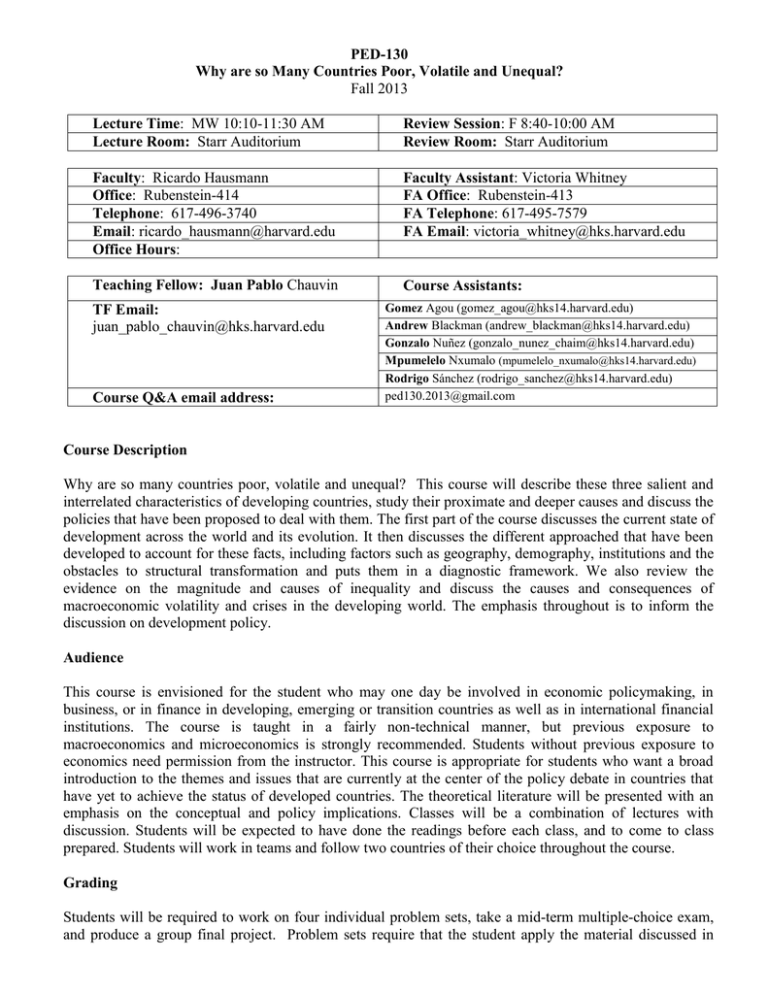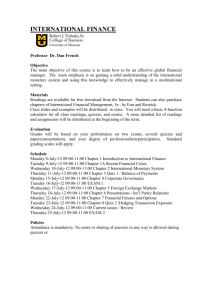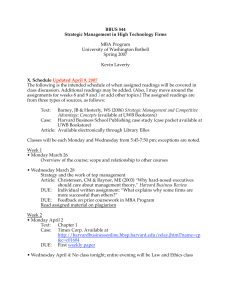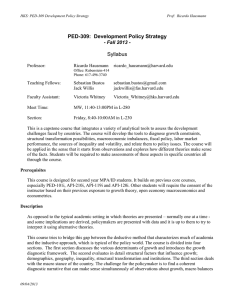
PED-130
Why are so Many Countries Poor, Volatile and Unequal?
Fall 2013
Lecture Time: MW 10:10-11:30 AM
Lecture Room: Starr Auditorium
Review Session: F 8:40-10:00 AM
Review Room: Starr Auditorium
Faculty: Ricardo Hausmann
Office: Rubenstein-414
Telephone: 617-496-3740
Email: ricardo_hausmann@harvard.edu
Office Hours:
Faculty Assistant: Victoria Whitney
FA Office: Rubenstein-413
FA Telephone: 617-495-7579
FA Email: victoria_whitney@hks.harvard.edu
Teaching Fellow: Juan Pablo Chauvin
Course Assistants:
TF Email:
juan_pablo_chauvin@hks.harvard.edu
Course Q&A email address:
Gomez Agou (gomez_agou@hks14.harvard.edu)
Andrew Blackman (andrew_blackman@hks14.harvard.edu)
Gonzalo Nuñez (gonzalo_nunez_chaim@hks14.harvard.edu)
Mpumelelo Nxumalo (mpumelelo_nxumalo@hks14.harvard.edu)
Rodrigo Sánchez (rodrigo_sanchez@hks14.harvard.edu)
ped130.2013@gmail.com
Course Description
Why are so many countries poor, volatile and unequal? This course will describe these three salient and
interrelated characteristics of developing countries, study their proximate and deeper causes and discuss the
policies that have been proposed to deal with them. The first part of the course discusses the current state of
development across the world and its evolution. It then discusses the different approached that have been
developed to account for these facts, including factors such as geography, demography, institutions and the
obstacles to structural transformation and puts them in a diagnostic framework. We also review the
evidence on the magnitude and causes of inequality and discuss the causes and consequences of
macroeconomic volatility and crises in the developing world. The emphasis throughout is to inform the
discussion on development policy.
Audience
This course is envisioned for the student who may one day be involved in economic policymaking, in
business, or in finance in developing, emerging or transition countries as well as in international financial
institutions. The course is taught in a fairly non-technical manner, but previous exposure to
macroeconomics and microeconomics is strongly recommended. Students without previous exposure to
economics need permission from the instructor. This course is appropriate for students who want a broad
introduction to the themes and issues that are currently at the center of the policy debate in countries that
have yet to achieve the status of developed countries. The theoretical literature will be presented with an
emphasis on the conceptual and policy implications. Classes will be a combination of lectures with
discussion. Students will be expected to have done the readings before each class, and to come to class
prepared. Students will work in teams and follow two countries of their choice throughout the course.
Grading
Students will be required to work on four individual problem sets, take a mid-term multiple-choice exam,
and produce a group final project. Problem sets require that the student apply the material discussed in
class to the two countries they will follow throughout the semester. Students will select countries based on
their own particular interests, provided that the necessary data is available.
The grading breakdown is as follows:
Problem Set 1: 10%
Problem Set 2: 20%
Mid-term exam: 20%
Problem Set 3: 10%
Problem Set 4: 10%
Final Paper:
30%
There will be no final exam.
Materials
The course does not have a single organizing textbook, It is based mostly on a collection of papers.
However, the following books are very good references and are available at the COOP and Harvard
Libraries:
-
David N. Weil, Economic Growth, Pearson Addison Wesley.
William Easterly, 2001, The Elusive Quest for Growth, Cambridge, MA. MIT Press.
Oded Galor, 2011, Unified Growth Theory. Princeton University Press.
Elhanan Helpman, The Mystery of Growth, Cambridge, MA. MIT Press.
Banerjee, Abhijit and Esther Duflo (2010) Poor Economics
Kling and Schulz (2009) From Poverty to Prosperity
Most of the readings are accessible through the Internet, and you can find them either through the course
webpage or through any Web search engine. There is also hyperlinks to these readings in the electronic
version of this document (follow the underlined titles of the readings).
Here are some additional links that you may find useful:
- The online service provided by the library is at http://lib.harvard.edu/eresources/type/electronic_journals/
- National Bureau of Economic Research (NBER): http://www.nber.org
- International Monetary Fund http://www.imf.org
- World Bank: http://www.worldbank.org
- Inter-American Development Bank: http://www.iadb.org/res/
- Older published papers are available through http://www.jstor.org, many recent working papers are also
available at http://www.ssrn.com. Good resources are available at The Economic Growth Resources at
http://growth.blogs.ilrt.org/ and the World Bank at http://www.worldbank.org.
- The most up to date resources for recently published papers are Google Scholar and Primo Central.
They both can be accessed through the Harvard Kennedy School Library webpage at:
http://www.hks.harvard.edu/library/ (you will be asked for your PIN number and password to be able to
access the Harvard University account, which gives you free access to these services). At the library
webpage you can also find several very useful data sources in the “Research Guide” section.
- The Observatory of Economic Complexity: www.cid.atlas.edu
2
1.
Friday, September 6. The Short History of Long-Term Development
2.
Maddison, Angus 2001. The World Economy: A Millennial Perspective, OECD Development Centre
Studies, Introduction, Summary and Ch. 1. (Also skim Appendix A).
Monday, September 9. The Malthusian Equilibrium: Is Malthus still alive?
3.
Easterly (2001), The Elusive Quest for Growth, Cambridge, MA. MIT Press. Chapter 1.
World Bank, Economic Growth in the 1990s: Learning from a Decade of Reform (2004). Part I:
Facts of the 1990s.
Weil, David. Economic Growth, Pearson Addison Wesley (2005), Chapter 4 (without the
Appendix).
Wednesday, September 11. The Escape from the Malthusian Trap, Geography and Diversity
Galor, O. (2011). Unified Growth Theory. Chapter 2: “From Stagnation to Growth”
Diamond, J. 1997. Guns, Germs, and Steel. New York: W.W. Norton and Co., Ch. 4-6.
Additional Optional Readings:
4.
Weil, David. Economic Growth, Pearson Addison Wesley (2005), Section 9.1.
Monday, September 16. The Neo-Classical Growth Model
Helpman, E. (2004), Chapter 1-4.
Additional Optional Readings:
Easterly, W. (2001), The Elusive Quest for Growth, Cambridge, MA. MIT Press. Chapter 2.
5. Wednesday, September 18. Endogenous Growth, the Diffusion of Knowledge, and Self-Discovery
Jones, Charles I., and Paul M. Romer. 2010. "The New Kaldor Facts: Ideas, Institutions, Population,
and Human Capital." American Economic Journal: Macroeconomics, 2(1): 224-45.
Hausmann, Ricardo, et al. "The Atlas of Economic Complexity." Boston. USA (2013). Section I:
“What do we mean by economic complexity?” (pgs. 15-18)
Additional Optional Readings:
Hausmann, Ricardo, and Dani Rodrik. "Economic development as self-discovery." Journal of
development Economics 72.2 (2003): 603-633.
6.
Monday, September 23. Knowledge, Institutions and Development
North, Douglass (1993) Nobel Prize Lecture.
Rodrik, D. 2000 “Institutions for High-Quality Growth: What they are and How to Acquire them”,
NBER Working Paper No. W7540.
Additional Optional Readings:
Helpman, E. 2004 “The Mystery of Economic Growth” Chapter 7
3
7.
Wednesday, September 25. Structural Transformation I
Problem Set 1 due in class
Hausmann, Ricardo, et al. "The Atlas of Economic Complexity." Boston. USA (2013). Sections 2 and
3 (pgs. 20-33)
Hausmann, Hwang, Jason and Rodrik, Dani “What You Export Matters” CID Working Paper No.
123, March 2006.
Additional Optional Readings:
Hidalgo, César and Ricardo Hausmann (2009) “The building blocks of economic complexity”,
Proceedings of the National Academy of Sciences 106 10570–10575.
Monday, September 30. Structural Transformation II – The Product Space
8.
Hausmann, Ricardo, et al. "The Atlas of Economic Complexity." Boston. USA (2013). Section 4:
“How is Economic Complexity Different from Other Approaches?” (pgs. 35-49).
Hidalgo, Klinger, Barabasi and Hausmann “The Product Space Conditions the Development of
Nations”, Science 317(5837) 482-487.
Additional Optional Readings:
9.
Hausmann, Ricardo and Klinger, Bailey Structural Transformation and Patterns of Comparative
Advantage, CID, KSG. June 2006.
Wednesday, October 2. Navigating the Product Space
Hausmann, Ricardo, et al. "The Atlas of Economic Complexity." Boston. USA (2013). Section 5:
“How does Economic complexity evolve?” (pgs. 51-63).
The Observatory of Economic Complexity: http://www.atlas.cid.harvard.edu
10.
Monday, October 7. High-Bandwidth Policy Making
Hausmann, Ricardo (2008) “The Other Hand: High Bandwidth Development Policies”, CID WP #
179.
Hausmann R. and Rodrik, D. (2006) Doomed to Choose: Industrial policy as predicament.
11.
Wednesday, October 9. Inequality: Definitions and Stylized Facts
Agenor, Pierre-Richard (2004). The Economics of Adjustment and Growth. Second Edition. Chapter
10: “Growth, Porverty and Inequality: Basic Facts”. Cambridge: Harvard University Press.
Additional Optional Readings:
Sen, A. (1992). Inequality Reexamined, Cambridge: Harvard University Press. Chapter 1-2.
Monday, October 14. Holiday (Columbus Day)
12.
Wednesday, October 16. Inequality: Deeper Determinants
De Ferranti, David; Perry, Guillermo E.; Ferreira, Francisco; and Walton, Michael. “Chapter 3:
Group-Based Inequalities: The Roles of Race, Ethnicity, and Gender” in Inequality in Latin America:
Breaking with History?. World Bank, 2004. Washington, D.C.
4
Additional Optional Readings:
Nunn N. Shackled to the Past: The Causes and Consequences of Africa's Slave Trade. In: Diamond J,
Robinson JA Natural Experiments of History. Cambridge: Harvard University Press; 2010. p. 142184.
13.
Monday, October 21. Inequality: What Policies?
Problem Set 2 due in class
World Development Report 2006 “Equity and Development.” Part II, Equitable Public Action in the
Domestic Arena: Broadening Opportunities. Chapter 6-8.
14.
Wednesday, October 23. The Volatility Puzzle: Facts and Theoretical Approaches
Wolf, Holger (2005). “Volatility: Definitions and Consequences”, in Aizenman, J. and B. Pinto:
Managing Economic Volatility and Crises: A Practitioner’s Guide. New York: Cambridge
University Press.
HnatkovskaV. and N. Loayza (2005). “Volatility and Growth”, in Aizenman, J. and B. Pinto:
Managing Economic Volatility and Crises: A Practitioner’s Guide. New York: Cambridge
University Press.
15.
Monday, October 28. Volatility and commodity prices
Hausmann and Rigobon “An alternative explanation of the resource curse: theory and policy
implications” http://www.nber.org/papers/w9424.
Devlin, J. and M. Lewin (2005): “Managing Oil Booms and Busts in Developing Countries”, in
Aizenman, J. and B. Pinto: Managing Economic Volatility and Crises: A Practitioner’s Guide. New
York: Cambridge University Press.
16.
Wednesday, October 30. Volatility: Fiscal Risk, Fiscal Pro-cyclicality and the “Original Sin”
Problem Set 3 due in class
Eichengreen, Hausmann and Panizza (2004) “The Pain of Original Sin”.
Additional Optional Readings:
Hausmann R. (2003) “Good credit ratios, bad credit ratings: the role of debt denomination”
http://ksghome.harvard.edu/~rhausma/paper/GCRBCR-3.2003.pdf.
17.
Monday, November 4. MIDTERM EXAM (in class)
18.
Wednesday, November 6. Growth Diagnostics I: Motivation and strategy
Rodrik, D. Diagnostics before prescription. (2010) Journal of Economic Perspectives, Vol 24, No. 3
Hausmann, R., Rodrik, D. and Velasco, A, (2005) “Growth Diagnostics” Harvard University.
Additional Optional Readings:
Rodrik “Goodbye Washington Consensus, Hello Washington Confusion?” Harvard University,
January 2006.
Monday, November 11. Holiday (Veteran’s Day)
19.
Wednesday, November 13. Growth Diagnostics II: Method
Problem Set 4 due in class
5
Hausmann, Klinger, Wagner (2008) “Doing Growth Diagnostics in Practice: a Mindbook”, CID WP
No. 177.
Additional Optional Readings:
Rodrik, D. “Growth Strategies”. Working draft for the Handbook of Economic Growth. John F.
Kennedy School of Government. Cambridge, MA September 2003.
20.
Monday, November 18. Growth Diagnostic in Practice I: Finance
Hausmann, R. (2008) “In search of the chains that hold Brazil back”, CID Working paper No. 180.
Mishkin, F. (2000) “Prudential supervision: Why is it important and what are the issues?”
http://www.nber.org/papers/w7926
Additional Optional Readings:
Pritchett, Lant and Preya Sharma (2008) “Implementing Growth Analytics: Motivation,
Background, Implementation”
21.
Wednesday, November 20. Growth Diagnostic in Practice II: Low appropriability or Low
Social Returns
Pritchett, Lant. 2009. “Does Schooling Help Explain any of the Big Facts About Growth?”
Mauro, Paolo (1996) “The Effects of Corruption on Growth, Investment and Government
Expenditures: A Cross-Country Analysis”
22.
Monday, November 25. Growth Diagnostics in Practice V: Examples
Hausmann, Ricardo, and Dani Rodrik. "Self-Discovery in a Development Strategy for El Salvador."
Economía - Journal of the Latin American and Caribbean Economic Association 6(1): 43-101,
2005.
Hausmann, Ricardo and Bailey Klinger. (2007) “Growth Diagnostics: Belize”.
23.
Wednesday, November 27. BBNN: External and Internal Balance
Rigobon, Roberto (2012) “Managerial International Macroeconomics BB-NN”. MIT Sloan.
Additional Optional Readings:
Caves R., J. Frankel and R.W.Jones (2007). World Trade and Payments: An Introduction. 10th
Edition. Chapter 15: “The Balance of Payments Accounts”. (pgs. 273-288). Chapter 18: “Spending
and the Exchange Rate in the Keynesian Model” (pgs. 327-344). Chapter 20: “Developing
Countries and Other Small Open Economies with Non-traded Goods” (pgs. 391-407)
24.
Monday, December 2. Why Are So Many Countries Poor, Volatile, and Unequal?
25.
Wednesday, December 4. Final Lecture: A policy makers view
Wednesday, December 11. FINAL PAPER DUE (drop box outside of Prof. Hausmann’s office)
6






